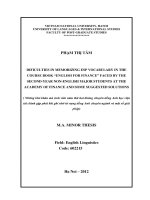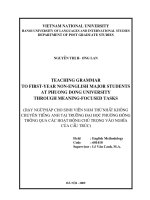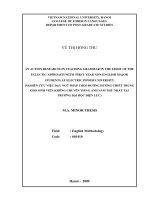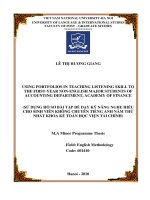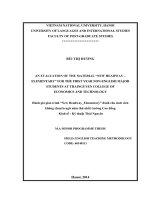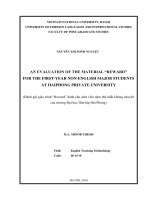DESIGNING a SUPPLEMENTARY SPEAKING MATERIAL FOR THE FIRST YEAR NON ENGLISH MAJOR STUDENTS AT TUYEN QUANG COLLEGE
Bạn đang xem bản rút gọn của tài liệu. Xem và tải ngay bản đầy đủ của tài liệu tại đây (2.75 MB, 74 trang )
(Thiết kế giáo trình bổ trợ dạy kĩ năng nói cho sinh viên
không chuyên Anh năm thứ nhất trường Cao đẳng Tuyên Quang)
!"# $%&" '(!)*( %&!+(,#,",&-
,#! $./01/000
Hanoi, 2015
2
(Thiết kế giáo trình bổ trợ dạy kĩ năng nói cho sinh viên
không chuyên Anh năm thứ nhất trường Cao đẳng Tuyên Quang)
!"# $%&" '(!)*( %&!+(,#,",&-
,#! $./01/000
34!56 ',5 $578%&(9:
Hanoi, 2015
My name’s Lương Thị Hải Hà, I hereby certify that my M.A thesis entitled
“Designing a supplementary speaking material for the first year non-English major
students at Tuyen Quang College” is the result of my own research in the fulfillment of the
requirement for Degree of Master of Arts at the Faculty of Post Graduate Studies –
University of Languages and International Studies, Vietnam National University, Hanoi.
I commit that this thesis has not been submitted anywhere for any degree.
Hanoi, 2015
Lương Thị Hải Hà
i
;
First and foremost, I would like to express my deepest gratitude to my
supervisor, Dr. Dương Thị Nụ, for her invaluable inspiration, assistance, guidance and
encouragement during the time I have tried to complete this thesis. She has been
willing to give help and advice whenever I expect.
I wish to take this opportunity to express my sincere thanks to all lectures and
the staff of Faculty of Post Graduate Studies at University of Languages and
International Studies, Vietnam National University, Hanoi for their interesting and
helpful lectures and suggestions for the topic of my study.
I am in debt of many authors’ works and ideas, which enhance me to complete
my study with sharp evidences.
My thanks also go to my colleagues and the first year students of Nursery and
Primary Faculty at Tuyen Quang College, who participated in doing the survey and
responding to my interviews.
Last but not least, I wish to express my appreciation to my family, my beloved
husband, my son for their constant encouragement, sympathy and supporting.
ii
<
This minor thesis was conducted in an attempt to investigate the gaps between
the speaking tasks offered in the course book “Lifelines” (Pre-intermediate) and the
non-English major students’ demand at Tuyen Quang College, in the hope of
designing a suitable supplementary material to teach speaking skills to suit students’
level.
In the study, two instruments (survey questionnaires and interviews) were
employed to achieve the purposes of the study. The subjects involved in this study
were 100 students, coming from Nursery and Primary Department. They were invited
to participate in the survey questionnaires. Besides, five teachers of English agreed to
join the study to support the researcher better her research.
It can be said that the course book “Lifelines” (Pre- intermediate) by Tom
Hutchinson (2006) does not really meet the students’ needs. Although the speaking
topics are familiar to students, there are not various types of speaking activities.
Moreover, the course book does not supply enough vocabulary items and grammatical
structures related to the speaking topics.
Based on the findings, the students prefer to have a supplement speaking
material which provides them with further practice in vocabulary, grammar as well as
speaking. Therefore, it is necessary to design a supplementary speaking material to suit
students’ level. It is said that this supplementary speaking material can supply more
language knowledge for the students and it can be a useful material for them to study
speaking skills better.
iii
<
i
; ii
< iii
< iv
$ 1
1. Rationale 1
2. Aims and objectives of the study 2
3. Research questions 2
4. Scope of the study 3
5. Methods of the study 3
6. Design of the study 3
<$ 5
0$< 5
1.1 An overview of speaking 5
1.1.1 Definition of speaking 5
1.1.2 Principles for teaching speaking skills 5
1.1.3 The techniques in teaching speaking skills 6
1.1.3.1 Pair work 6
1.1.3.2 Group work 6
1.1.4 Some common activities to promote speaking skills 7
1.1.4.1 Information gap activity 7
1.1.4.2 Interviews 7
1.1.4.3 Role play 7
1.1.4.4 Discussion 8
iv
1.2 Materials evaluation 8
1.2.1 Definition of materials evaluation and its criteria 8
1.2.2 Materials adaptation 9
1.3 Supplementary materials for teaching speaking skills 10
1.3.1 Definition of supplementary materials 10
1.3.2 Goals of supplementary materials 10
1.3.3 Forms and process of supplementary materials 11
1.3.4 Review of previous studies related to supplementary materials 12
1.4 Summary 13
=$ 01
2.1 The research context 14
2.1.1 Description of the English teaching and learning situation at TQC 14
2.1.2 The first year students 14
2.1.3 The teachers 15
2.2 Methodology 15
2.2.1 Subjects of the study 15
2.2.2 Research methods 16
2.2.3 Instruments of data collection 16
2.2.4 Procedure of data collection 17
>$ 0?
3.1. The evaluation of the speaking activities offered in the course book 18
3.2 Data analysis on survey questionnaires 18
3.2.1 The students’ background and attitudes of English learning 18
3.2.2 The evaluation of the speaking activities in the course book
by teachers and students 21
v
3.2.3 Students’ needs when learning speaking skills 25
3.3 Data analysis on interviews 30
3.4 Summary 30
1$
>=
4.1 Supplementary speaking material for unit 1 32
4.2 Supplementary speaking material for unit 2 34
4.3 Supplementary speaking material for unit 3 35
4.4 Supplementary speaking material for unit 4 36
4.5 Supplementary speaking material for unit 5 37
4.6 Summary 38
$ 39
5.1 Conclusions 39
5.2 Limitations and suggestions for further study 40
10
vi
$
In this part A, the researcher will introduce the rationale, the aims, the research
question, the scope, the method and the design of the study.
0)+ ,%)"!
As an international language, English plays an important role in society. It is
broadly used in many different fields of life such as science, technology, medicine,
economy, education, so forth. With the wide spread of globalization and the rapid
expansion of information technologies, there has been an explosion in the demand for
English. That is the reason why teaching and learning English has been paid more
attention to recently in Vietnam. There has been an increasing number of people
desiring to know English and master English with different purposes and a large
percentage of the purpose of language learners studying English is to develop
proficiency in speaking. Richards (2008:19) points out that “of four major language
skills: listening, speaking, reading, writing; the mastery of speaking skill in English is
a priority for many second - language or foreign language learners.” Consequently, the
success of learners in language learning is often evaluated on the improvement in their
spoken language proficiency.
In fact, there are many speaking course books to cater teachers and learners in
their teaching and learning speaking skills. At Foreign Language Faculty (FLF) of
Tuyen Quang College (TQC), the course book “Lifelines” (Pre-intermediate) by Tom
Hutchinson (2006) has been recommended and used as a core one to teach speaking
skills to the first year non-English major students because it is supposed to be a rather
reliable source to enhance students’ speaking ability.
However, this course book is not really suitable for the first year students. The
ineffectiveness of this course book has caused some considerable problems. In the
teaching process, some teachers at FLF complain about spending much time compiling
and adapting materials in order to meet their students’ needs and make the speaking
lessons more interesting and motivating.
1
Although the topics of speaking lessons are familiar to students, there are a few
activities which make the speaking lessons boring. Moreover, almost speaking lessons
do not supply enough vocabulary items and grammatical structures to students. It is
the problem that makes students feel less confident when learning speaking skills.
Therefore, it is necessary to design a supplementary speaking material in order
to provide enough adequacies in terms of speaking activities to help them speak
English better. Hopefully, with a supplementary speaking material, the gaps between
the course book and the students’ needs can be narrowed down. The above reasons
have urged the author to conduct a study entitled “Designing a supplementary
speaking material for the first year non-English major students at Tuyen Quang
College”.
= @')%#,AB!*+ 6!',C+(!'+3#-
The study was carried out with the aim to propose an additional speaking
material in the speaking sections of the course book “Lifelines” (Pre- intermediate) in
the hope of satisfying the students’ demand and helping them improve their speaking
ability.
In order to achieve the above mentioned aims, the main objectives in carrying
out this study are as follows:
+ To describe characteristics of non-English major students at Tuyen Quang
College in terms of English speaking competence in order to investigate their
difficulties, demand and preferences.
+ To find out the inadequacies in terms of speaking activities in the course book
“Lifelines” (Pre- intermediate) compared to the students’ needs.
+ To propose a sample of supplementary speaking material that may help
improve students’ speaking skills.
>!'!)5*(D3!'+ ,%'
The study includes two major research questions:
2
1, What are the gaps between the speaking tasks offered in the course book
“Lifelines” (Pre-intermediate) and the non-English major students’ demand at Tuyen
Quang College?
2, What are the contents of the supplementary speaking material?
1*,4!,C+(!'+3#-
The study was conducted at Tuyen Quang College. Because of limited time, it
only focused on finding out the inadequacies in terms of speaking activities in the
course book “Lifelines” (Pre- intermediate) according to the students’ needs with the
aim of designing a supplementary speaking material to suit the students’ level.
The participants were 100 first year students of Nursery and Primary Faculty
and five teachers. Focusing specifically on speaking skills for the first year students is
to help them understand and communicate daily in English at A2 level based on the
framework language skills.
E!+(,#',C+(!'+3#-
To achieve the aims stated, quantitative and qualitative methods were mainly
used. The collected data for the study comes from 100 first year students at TQC who
have just finished studying English 1 with 45 periods and five teachers have taught
English 1 to the first years for at least 5 years.
Survey questionnaires were used to collect information and evidence for the
study. In addition, the researcher also used qualitative method based on the personal
interviews. The researcher hopes that the research methods will supplement each other
to ensure the data reliability.
.!' &%,C+(!'+3#-
The study consists of three main parts, a list of reference and appendices.
)5+$provides an overview of the study including rationale, aims, research
questions, scope, method and design of the study.
)5+<$consists of 4 chapters
3
+ Chapter 1: provides an overview theoretical background to speaking skills,
materials evaluation and supplementary material development.
+ Chapter 2: briefly presents the methodology framework of the study. It covers
the setting, the subjects, the instruments and procedure of data collection and data
analysis.
+ Chapter 3: pressents detailed data analysis and findings discussion
+ Chapter 4: Proposes a sample of supplementary speaking material for the first
year non-English major students at TQC.
)5+ $ comes up with the recapitulation of the study, limitations and
suggestions for further study.
4
<$
0$<
00%,6!56 !F,C'4!)G %&'G ""'
000!C % + ,%',C'4!)G %&'G ""'
Many researchers have given different definitions of speaking skills. Chaney
and Burk (1998: 13) argues that “speaking is the process of building and sharing
meaning through the use of verbal and non-verbal symbols, in a variety of contexts.”
Brown (1994b) points out “speaking is an interactive process of constructing meaning
that involves producing, receiving and processing information. Its form and meaning
are depending on the context in which it occurs, including the participants,
experiences, the physical environment and the purposes for speaking. It is often
spontaneous, open-ended and evolving”. Nunan (2003:48) defines “speaking is the
productive oral skill. It consists of producing systematic verbal utterances to convey
meaning.” From the above definitions, it can be inferred that speaking skills are
communicative activities between participants with the purpose to obtain and transmit
information.
00=5 %* 4"!'C,5+!)*( %&'4!)G %&'G ""'
When teaching speaking, there are some principles that teachers should follow
to ensure the effectiveness of speaking lessons. In the book “Language Teaching
Methodology” published in 1991, Nunan suggests five principles for teaching
speaking skills as follows:
• Be aware of the difference between second language and foreign language
learning contexts
• Give students practice with both fluency and accuracy
• Provide opportunities for students to talk by using group works or pair works
and limiting teacher talk
• Plan speaking tasks that involve negotiation for meaning
5
• Design classroom activities that involve guidance and practice in both
transactional and interactional speaking in which transactional speech involves
communicating to get something done and interactional speech is
communicating with someone for social purposes, establishing and maintaining
social relationships.
Therefore, in the process of teaching speaking skill, teachers should follow
principles in order to help students to improve their speaking ability effectively.
00>(!+!*(% D3!' %+!)*( %&'4!)G %&'G ""'
There are many useful techniques in teaching speaking skills in order to help
students learn speaking English skills effectively. However, pair and group work
activities are considered to be the most common practices in a language classroom, in
which students are allowed to interact with each other and then they will be able to
communicate in the target language.
00>0) 5F,5G
According to Adrian Doff (1988:137) “Pair work is a process in which the
teacher divides the whole class into pairs. Every student works with his or her partner
in pairs, and all the pairs work at the same time. This is not the same as “public” or
“open” pair work, with pairs of students speaking in turn in front of the class.” In this
case, it can be said that pair work is an activity that gives students an opportunity of
talking to each other and practicing language together.
00>=5,34F,5G
Like the activities of pair work, Adrian Doff (1988:137) also defines group
work as a process that “the teacher divides the class into small groups to work together
(four or five students in each group), as in pair work, all the groups work at the same
time.”
It is clear that group work is a cooperative activity. In this activity, students
have opportunities of sharing ideas and responsibilities with other members in the
6
group. They can work without the pressure of the whole class listening to what they
are saying. Moreover, they can feel free to use the language.
001,@!*,@@,%)*+ 6 + !'+,45,@,+!'4!)G %&'G ""'
Many famous researchers such as Klippel (1984), Doff (1988) and Harmer
(1998) discuss classroom activities and a lot of activities are designed in order to
promote students’ speaking ability. Here are some common activities to promote
speaking skills.
0010%C,5@)+ ,%&)4)*+ 6 +-
In this activity, learners need to complete a task and need to talk to each other
to find the missing information. Learners are supposed to work in pairs. Therefore,
each partner plays an important role because the task cannot be completed if the
partners do not provide the information the others need. This activity is effective
because learners will have the opportunity to talk extensively in the target language.
001=%+!56 !F'
This activity often requires students in the class to work in pairs and interview
each other. The purpose of this activity is to get to know the other individual. Before
conducting interviews, it is essential for teachers to provide the students with the
contents that need to be interviewed for. Therefore, students can know what type of
questions they can ask or what path to follow. However, students have to prepare their
own interview questions. In short, conducting interviews will help students to have
chance to practice their speaking ability not only in class but also outside daily
activities.
001>,"!4")-
A role play is a kind of a life game that has goals and rules. It is interesting and
useful for students because they are put in a certain atmosphere outside of the class
atmosphere. This activity can motivate students in learning the language. According to
Harmer (1984), role play is fun and motivating. Quieter students get a chance to
7
express themselves in a more forthright way (cited in Dinamika Bahasa & Budaya
Vol.3, No2, 2009). Ladousse (1987) states that using a role- play promotes interaction
in the classroom and increases students’ motivation. It can improve students’ speaking
skills in any situation and help them to interact. As for the shy students, role play helps
provide a mask where students with difficulty in conversation are open minded. In
fact, it is widely agreed that enjoyment leads better learning.
0011 '*3'' ,%
In this activity, teachers often give a topic and instructions to the students and
then they set a time to discuss. In a discussion, students feel more comfortable when
they discuss with members in their group about a topic given by their teacher. Students
will have an opportunity to express their ideas and use the target language. In other
words, “discussion is an engagement in and a practice of the activities of thought and
communication” (cited in Schwa (1954:54)). In addition, Larson (1999: 662) thinks
that discussion is a useful teaching technique for developing higher-order thinking
skills. Students can express their ideas and thought rather than merely recount or recite
memorized facts and details. During discussion students are not passive recipients of
information that is transmitted from a teacher.
In summary, the activities presented in this section do not cover all the activities
that teachers apply in the class. However, the above mentioned activities should be
exploited and applied in the class because of their efficiency in teaching and learning
language skills.
0=)+!5 )"'!6)"3)+ ,%
0=0!C % + ,%,C@)+!5 )"'!6)"3)+ ,%)%# +'*5 +!5 )
Materials evaluation is defined by different authors. Brown (1995: 218) defines
that “Evaluation is the systematic collection and analysis of all relevant information
necessary to promote the improvement of a curriculum, and assess its effectiveness
and efficiency, as well as the participants’ attitudes within the context of the particular
institutions involved.” In line with materials evaluation, Tomlinson (1998: xi) states
8
that “the systematic appraisal of the value of materials in relationship to their
objectives and to the objectives of the learners using them.”
Materials evaluation is based on different criteria. Cunningsworth (1984:5-6)
gives four main principles of evaluation which are applied by many teachers and
students in a great variety of teaching and learning contexts. The four main principles
of evaluation are mentioned as follows:
* Relate the teaching materials to your aims and objectives
* Be aware of what language is for and select teaching materials, which help
equip your students to use language effectively for their own purposes
* Keep your students’ learning needs in mind
* Consider the relationship between language, the learning process and the
learner
In brief, materials evaluation is a crucial task in language teaching. Evaluating
good points as well as finding out limited points will help teachers choose suitable
materials for students. Hopefully, students can improve their skills in the process of
learning a foreign language.
0==)+!5 )"')#)4+)+ ,%
It is said that materials adaptation has a close relationship with materials
evaluation and it has the importance in the process of materials development.
Tomlinson (1998: xi) defines that “making changes to materials in order to improve
them or make them more suitable for a particular type of learner.” He also points out
that adaptation can include reducing, adding, omitting, modifying and supplementing
materials. The purpose of teachers when adapting materials is to maximize the value of
the book for their particular learners. Discussing the purpose of materials adaptation,
Mc Grath (2002: 64) mentioned two main reasons:
* To make the material more suitable for the circumstances in which is being used
9
* To compensate for any intrinsic deficiencies in the material, such as linguistic
inaccuracies, out of datedness, lack of authenticity (Madsen and Bowen(1978) or lack
of variety (Tice 1991))
It can be said that materials adaptation is an important task in the teaching
process with the hope of maximizing the appropriateness of the materials.
0>344"!@!%+)5-@)+!5 )"'C,5+!)*( %&'4!)G %&'G ""'
0>0!C % + ,%,C'344"!@!%+)5-@)+!5 )"'
In the book “Materials Development in Language Teaching” published in 1998,
Tomlinson gives his opinions that “materials designed to be used in addition to the
core materials of a course. They are usually related to the development of skills of
reading, writing, listening or speaking rather than to the learning of language items.”
In fact, most language teaching course books probably need supplementing to some
extent in the hope of tailoring the needs of a particular class or to help learners master
the foreign language. According to Ur (1991), there are packages of supplementary
materials such as computers, simplified readers, overhead projectors, posters, pictures
or games, etc. Each type, obviously, has certain contributions to language teaching and
its own good points as well as drawbacks based on how it is used by the teachers and
learners in learning a foreign language.
0>=,)"',C'344"!@!%+)5-@)+!5 )"'
Besides the textbook, it is essential for teachers to use other materials for
different goals. Mc Grath (2002) points out two main goals for choosing other
materials. First, they wish to narrow down the gap or unsuitable things between
textbook and official syllabus with students’ needs. Second, teachers want to use
supplementary materials in order to cater for various language competence levels or
different needs of specific individuals in a class. In line with above ideas, Brown
(1994: 152) explains that using supplementary materials is to promote learners’
motivation which is considered as one of the most important factors in learning. In
addition, Richards (2005) also identifies that a textbook, which has some limitations,
10
should to be modified or supplemented to help teachers use them more suitably and
effectively. According to Mary Spratt, Alan Pulverness and Melanie Williams (2011:
161) there are five main goals of using supplementary materials as follows:
• to replace unsuitable material in the course book
• to provide material missing from the course book
• to provide suitable material for learners' particular needs and interests
• to give learners extra language or skills practice
• to add variety to our teaching
In short, most language teaching textbook probably needs supplementing to
some extent because it can promote learners’ motivation. However, the final purpose
of supplementary materials is to bridge the gap between the textbook and the students’
needs as well as to meet the demand of learners’ learning.
0>>,5@')%#45,*!'',C'344"!@!%+)5-@)+!5 )"'
On talking about forms of supplementary materials, Mc Grath (2000) mentions
two main ways. First, teachers can use items such as exercises, texts or activities from
other published source which are considered as the most common form of
supplementation. It can be inferred that when teachers use some items from published
materials in order to supplement a core book, they can follow exactly what has been
professionally prepared or they spend little time editing a little adaptation to such
materials. In fact, minimal adaptation can be useful and necessary so as to increase the
suitability of supplementary materials for the reality of teaching and learning foreign
languages. Second, teachers can devise their own material. Block (1991) says that,
teachers should prepare their own materials deriving from the dissatisfaction with
published material. Teacher-prepared material, he claims, is likely to be more up-to-
date and more relevant to students’ needs and interests than equivalent course book
material.
11
In terms of the process of choosing supplementary materials, Mc Grath (2002:
89) classifies two types namely “syllabus driven process” and “concept driven
process”. In “syllabus driven process”, he states that basing on an analysis of learner
needs; teachers can choose or design suitable supplementary materials. In addition,
teachers should choose materials that are appropriate for a particular class or particular
groups of learners in mind. In “concept driven process”, he states that teachers choose
some interesting materials accidentally in the hope that they can use such materials as
supplementation in their future teaching. Furthermore, in this process, teachers have no
class or no learn groups in mind.
0>1 !6 !F,C45!6 ,3''+3# !'
Many foreign researchers have conducted to study supplementary materials
towards learning foreign language generally and English as a foreign language
particularly. Namely, Andrew Jonas and Cho-Ming Chuang (2009) conducted a study
adopting supplementary materials to enhance listening and speaking strategy use by
Taiwanese college EFL learners. The results emphasizes that supplementary materials
applied into the target non-major English Listening and Speaking classes has promoted
students’ language skills. It enhances strategy use, with which students’ learning
results are also upgraded.
Dickinson (2010) studied evaluating and adapting materials for young learners.
It can be concluded that by adapting activities found in course books to make them
engaging tasks with clear learning goals teachers can provide young learners with
experiences that enhance opportunities for language learning.
Reddy (2013) researched on supplementary materials to enhance language
skills of learners. It points out supplementary materials can help a language teacher
when encountered with insufficient techniques and methods while teaching English in
a classroom.
Orista Vella Anggraningtyas and Suharmanto Ruslan (2013) conducted a study
developing supplementary speaking materials for the seven grades. The researchers
12
emphasized supplementary speaking materials which are appropriate with the syllabus
and encourage student-centered activities.
The above mentioned research focuses on finding the effectiveness of using
supplementary materials in real teaching situation. In summary, there are studies on
development of supplementary materials; nevertheless, there has little document
concerning the development of supplementary speaking materials. This study fills
this gap by developing supplementary speaking materials for
first year n o n -
English m ajor students at TQC who are using the course book “Lifelines” (Pre-
intermediate) in their speaking lessons.
013@@)5-
In brief, in this chapter, the researcher has tried to give an overview of the relevant
literature in the concern of the study. This chapter has dealt with all basic aspects for
designing a supplementary speaking material, including an overview of speaking
skills, materials evaluation as well as supplementary materials. Moreover, it helps the
teachers understand more deeply and acknowledge the importance of speaking skills and
material adaption in the process of teaching speaking skills.
13
=$
=0(!5!'!)5*(*,%+!H+
=00!'*5 4+ ,%,C+(!%&" '(+!)*( %&)%#"!)5% %&' +3)+ ,%)+
The study was conducted at Tuyen Quang College, which is located in the center
of Yen Son district, Tuyen Quang province. English is a compulsory subject there. The
course book “Lifelines” (Pre- intermediate) by Tom Hutchinson (2006) is used as an
official course book for the students. Concerning teaching and learning English at
TQC, the students here have three years training in the college but they have three
semesters learning English with the total of 150 periods. In the study, the researcher
only focuses on the first semester.
In the first semester, students learn English in 45 periods and students have to
study five units (from unit 1 to unit 5). The aims of this semester program are to
provide students with general knowledge of English grammar, vocabulary as well as
developing students’ four language skills. After finishing this semester, students can
develop their communicate competence and they can learn the real things from daily
life. The final purpose of this semester is that students have to reach A2 level based on
the framework language skills. In fact, however, both teachers and students face a
great deal of difficulties in teaching and learning speaking skills. English is taught and
learned only in the classroom. Students do not have environment for using and
communicating in English effectively outside the classroom. They do not have
opportunities to communicative with native speakers. Meanwhile, students are
assessed based on a written test of grammar exercises and reading comprehension at
the end of this semester. Therefore, listening and speaking skills are often ignored. All
of these difficulties lead to the fact that the students’ speaking competence, to some
extent, remained unimproved.
=0=(!C 5'+-!)5'+3#!%+'
Unlike students of other colleges and universities in the whole country, almost
the first year students at TQC come from provinces and mountainous areas. Their age
14
ranges from 18 to over 20. Almost students at TQC do not have the same level of
English language proficiency. Most of them have learned English for 7 years; some
have only learned English for 3 years while a few have never learned English. The
majority of students have the same ideas about learning English. They do not really
enjoy learning this subject and they do not feel self-confident in communicating in
English in front of other students. They only focus on learning grammar of English to
pass the paper test of grammar. Thus, motivation to learn English in class is generally
low.
=0>(!+!)*(!5'
If students are the most essential factor in learning process, teachers are the
most important factor in teaching process. At TQC, there are seven teachers of English
aged from 26 to 52 but none of them have ever been trained in English speaking
countries. Most of them hold a Bachelor’s degree. Although only two out of seven
teachers had a master degree in English, all of them have many years of teaching
experience.
Most of the teachers at this college still employ traditional methods to teach
English. The teachers always play the central role in teaching and learning process.
They focus more on language knowledge rather than language use. They often
concentrate on teaching vocabulary and grammar in traditional methods (teachers
teach, students take notes). Besides, they also focus on teaching listening and speaking
skills. However, the students’ speaking ability does not really reach to A2 level based
on the framework language skills. Therefore, this problem is usually discussed in the
professional meetings.
==!+(,#,",&-
==03AB!*+',C+(!'+3#-
The study was conducted at TQC. Two groups of respondents are chosen to
carry out the research. The first group includes 100 first year students, who are from
18 to 20 years old. They come from Nursery and Primary Department. The second
15
group includes five teachers of English Foreign Faculty at TQC. They all age from 26
to 35 who have had at least 5 years of teaching experience.
===!'!)5*(@!+(,#'
This survey research was carried out with two main data collection instruments,
namely questionnaires and interviews, and the procedures were as follows:
I,5'+3#!%+'$
The researcher randomly chose 100 students from the class (MNAK7, MNBK7,
THAK10, THBK10) of Nursery and Primary Faculty after they finished studying the
first semester. They participated in answering the survey questionnaire with the aims
of finding out their background and attitudes towards learning English, evaluating the
strengths and shortcomings of the course book as well as investigating their needs
when learning speaking skills.
I,5+!)*(!5'
5'+, five teachers aged from 26 to 35 who have had at least 5 years of
teaching experience were chosen to respond to the survey questionnaire and personal
interviews with the aims of :
- Surveying their evaluation on speaking activities in the course book towards
students’ level.
- Studying their evaluation on the contents of speaking activities in the course
book.
- Exploring their own suggestions to adapt speaking activities to suit student’s
level.
C+!5 the data were collected, sorted and analyzed quantitatively and
qualitatively, realistic results were obtained.
%)""-, a sample of supplementary speaking material for enhancing students’
ability to learning speaking skills will be proposed based on the results found from all
data collection instruments.
16
==>%'+53@!%+',C#)+)*,""!*+ ,%
The instruments used to collect data in this study were survey questionnaires
and interviews. First of all, two survey questionnaires were designed for both students
and teachers.
The survey questionnaires for students include three different parts. The first
part includes five questions in order to help the researcher find out students’
background and attitudes of English learning. The second part has five different
questions aiming at finding students’ evaluation of speaking activities in the course
book. The last part consists of five questions about students’ needs when learning
speaking skills.
The questionnaires for teachers consists of eight different questions aiming at
finding out the teachers’ evaluation of the speaking activities in the course book, their
needs in designing and using supplementary speaking material for this course book.
The structured interview questions for teachers are made of four questions about
teacher’s evaluation of the speaking activities as well as the adaptation of these activities
in the process of teaching speaking skills. The interview also focuses on exploring the
type of speaking activities which the teachers will choose in speaking lessons with the
hope of helping the students study speaking skills better.
==15,*!#35!,C#)+)*,""!*+ ,%
The data are collected and analyzed by following steps:
- First of all, the researcher carried out the survey questionnaires for both
students and teachers. The survey questionnaires are in Vietnamese and were
distributed directly to 100 students coming from the class (MNAK7, MNBK7,
THAK10, THBK10) of Nursery and Primary Faculty after they finished studying the
first semester.
- Secondly, personal interviews for teachers were conducted to explore more
reliable information for the study.
- Subsequently, from the survey questionnaires for both students and teachers;
personal interviews with teachers, data collected were then synthesized and sorted.
- After that, the results were analyzed and transcribed into tables and charts.
- The findings were recapitulated and represented in chapter 3.
17

